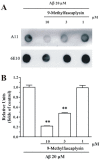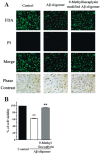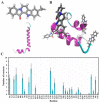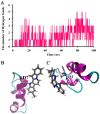9-Methylfascaplysin Is a More Potent Aβ Aggregation Inhibitor than the Marine-Derived Alkaloid, Fascaplysin, and Produces Nanomolar Neuroprotective Effects in SH-SY5Y Cells
- PMID: 30781608
- PMCID: PMC6409607
- DOI: 10.3390/md17020121
9-Methylfascaplysin Is a More Potent Aβ Aggregation Inhibitor than the Marine-Derived Alkaloid, Fascaplysin, and Produces Nanomolar Neuroprotective Effects in SH-SY5Y Cells
Abstract
β-Amyloid (Aβ) is regarded as an important pathogenic target for Alzheimer's disease (AD), the most prevalent neurodegenerative disease. Aβ can assemble into oligomers and fibrils, and produce neurotoxicity. Therefore, Aβ aggregation inhibitors may have anti-AD therapeutic efficacies. It was found, here, that the marine-derived alkaloid, fascaplysin, inhibits Aβ fibrillization in vitro. Moreover, the new analogue, 9-methylfascaplysin, was designed and synthesized from 5-methyltryptamine. Interestingly, 9-methylfascaplysin is a more potent inhibitor of Aβ fibril formation than fascaplysin. Incubation of 9-methylfascaplysin with Aβ directly reduced Aβ oligomer formation. Molecular dynamics simulations revealed that 9-methylfascaplysin might interact with negatively charged residues of Aβ42 with polar binding energy. Hydrogen bonds and π⁻π interactions between the key amino acid residues of Aβ42 and 9-methylfascaplysin were also suggested. Most importantly, compared with the typical Aβ oligomer, Aβ modified by nanomolar 9-methylfascaplysin produced less neuronal toxicity in SH-SY5Y cells. 9-Methylfascaplysin appears to be one of the most potent marine-derived compounds that produces anti-Aβ neuroprotective effects. Given previous reports that fascaplysin inhibits acetylcholinesterase and induces P-glycoprotein, the current study results suggest that fascaplysin derivatives can be developed as novel anti-AD drugs that possibly act via inhibition of Aβ aggregation along with other target mechanisms.
Keywords: Alzheimer’s disease; Aβ; fascaplysin; oligomer; β-carboline.
Conflict of interest statement
The authors declare no conflict of interest.
Figures









References
-
- Ulep M.G., Saraon S.K., McLea S. Alzheimer Disease. J. Nurse Pract. 2018;14:129–135. doi: 10.1016/j.nurpra.2017.10.014. - DOI
MeSH terms
Substances
Grants and funding
- 81870853, 21576199, 21878234, 20903058, 81850410553/National Natural Science Foundation of China
- 2017C50042/Ningbo Sci & Tech Project for Common Wealth
- 201804/Zhejiang Key Laboratory of Pathophysiology
- SKLFNS-KF-201806/Open Project Program of State Key Laboratory of Food Nutrition and Safety, Tianjin University of Science & Technology
- 2015C110026/Ningbo municipal innovation team of life science and health
LinkOut - more resources
Full Text Sources
Research Materials
Miscellaneous

